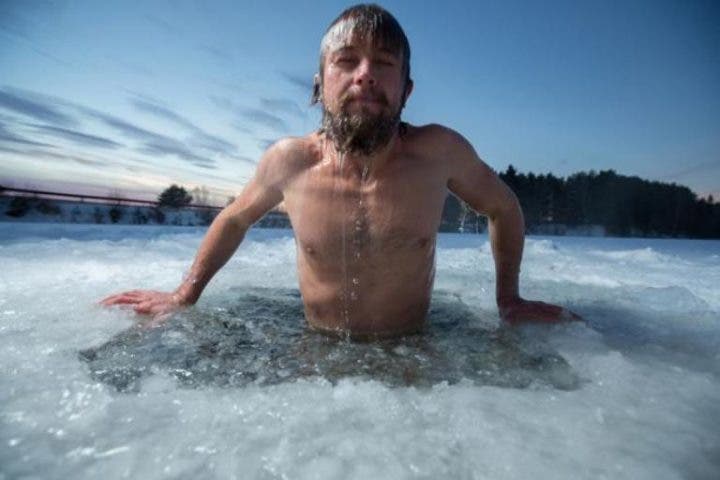Thermogenesis is the process by which heat is produced in the body and is primarily a result of your metabolism. Thermogenesis is activated by different mechanisms, such as the food we eat, exercise or, as the case at hand today, exposure to cold .
Cold-induced thermogenesis is the production of body heat during and after an exposure of the body to cold. The body must produce heat when it is exposed to it, because all the physiological and biochemical systems are designed to work at an optimal temperature, that is, at about 37 degrees Celsius.
How does cold-induced thermogenesis work?
There are two ways for the body to increase its metabolic rate and produce more heat:
- Through the muscles, trembling.
- Through the activation of brown adipose tissue , the one responsible for heating the body in case of exposure to cold.
Most adipose tissue in adults is white adipose tissue, which is relatively inactive. Until very recently, it was thought that only children had large amounts of brown adipose tissue; recently it has been discovered that adults possess it as well.
In adults with sufficient amounts of brown fat, exposure to cold can increase metabolic rate . Exposure to a room temperature of 19 degrees Celsius while wearing only underwear causes an increase of up to 30% in body energy expenditure, over a metabolic rate of 1,446 calories per day. If this energy expenditure were to be repeated continuously, large amounts of energy would be consumed. The problem is, to burn an extra 400 calories, you’d have to sit in a cold room in your underwear for about 20 hours a day.
Water has a greater ability to cool the body than air, therefore exposure to cold water is a more efficient way to cool the body. Immersing the whole body, head out, at a temperature of 20 degrees Celsius, causes a 93% increase in metabolic rate. If this were done over 24 hours, it would mean about 1500 more calories burned. An exposure to 14 degrees Celsius would multiply the metabolic rate by 350%. It would be the equivalent of 6750 calories per day, about 280 calories per hour.
Are cold showers effective in increasing metabolic rate?
Cold showers are not as effective as a full soak, but they are a reasonable alternative, with positive effects on fatigue, the immune system, and even depression. In fact, they are highly recommended to start the day in a more energetic way and especially when they are taken in the form of ” contrast showers ” (alternating 30 seconds of hot water for 30 seconds of cold water for several minutes) to help recovery. after intense workouts.
As we saw earlier, an hour-long exposure to room temperature of 19 degrees Celsius causes a 30% increase in metabolic rate . Since water is more efficient than air in this regard, it should take 5 minutes in the shower at the same temperature to achieve the same effect. If the metabolic rate is increased by at least 30% and lasts at least an hour, being generous, we would burn 21 calories in a cold shower.
If we took a shower at an even colder temperature, around 14 degrees Celsius and we were there for an hour and the increase in metabolic rate lasted two hours, once again being very generous, we would burn 560 extra calories. Given that no one has planned to spend an hour in the shower every day at that temperature, this is, to say the least, an unrealistic proposition.

Is exposure to cold better than exercise for burning calories?
Today many people are interested in cold thermogenesis as a way to burn calories without doing anything at all. However, there are a number of problems regarding this matter.
The first of these is that exercise burns far more calories than any reasonable and credible increase in metabolism through exposure to cold.
The amount of energy expended through exercise is measured in terms of metabolic equivalents or METs. A MET is the increase that a physical activity causes in the basal metabolic rate. For example, playing a game of tennis would have an intensity of 10 METs.
As we increase the intensity of the exercise, your amount of METs will increase. Even moderate physical activities increase metabolic rate more than exposure to cold water. Therefore, if you want to burn more fat, it is better to play a game for an hour than to stay in the shower with cold water for the same period of time. In particular, I find a tennis match more fun.
The final objection to the notion that increasing the metabolic rate through exposure to cold burns more fat is the same as with exercise: it is very easy to recover what was “burned” through food. Increasing your metabolism does not have any advantage over exercise in this regard. If you do not control your diet, both exercise and exposure to the cold will not matter much in the face of losing weight.

Conclution
Certain well-known figures today have generated a great deal of interest and controversy about cold thermogenesis, probably because it is something new and different and because people are often looking for new solutions for fat loss . But, as we have seen before, cold thermogenesis is by no means a panacea. Generated in an impractical and comfortable way, it is currently not a recommended practice for large losses of weight and fat.
Although it is clear that certain exposures to the cold, such as cold showers, help with metabolic and recovery issues, its results in terms of fat burning are, to say the least, modest. A proper training plan combined with a diet focused on weight loss are actually more appropriate instruments for this purpose than cold thermogenesis, from which we cannot expect miracles.
